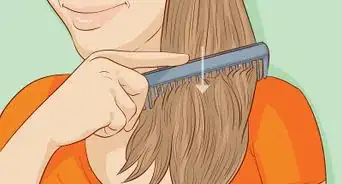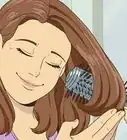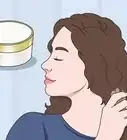This article was co-authored by Ashleigh Grounds. Ashleigh Grounds is a Makeup Artist and Hair Stylist based in Austin, Texas. Ashleigh has over 11 years of cosmetology experience. She studied cosmetology in Dallas, Texas and completed a two-year hair salon apprenticeship in Kuala Lumpur, Malaysia with Toni & Guy Hair Salon. She is accredited by the International Board of Cosmetology, is a certified Babe Hair Extension Professional, and is a certified Brazilian Blow Out Professional. Ashleigh was voted the best Hair Stylist in Austin for 2012 by RAW Artists and was voted in the top 20 salons for 2020 in Austin by Expertise. Ashleigh's work has been featured in Talentmagazines, BlogTalkRadio, KXAN, and Studio 512.
There are 15 references cited in this article, which can be found at the bottom of the page.
This article has been viewed 650,582 times.
Brushing your hair may sound like a straightforward task, but there are actually several things you can do to improve your brushing and keep your hair healthy and strong! Before you start working those tangles out, it's important to choose a brush or comb made of quality materials that will work well with your hair type. Always brush gently to work out tangles and distribute your hair's natural oils. Brush once a day and clean your brush every 2 weeks to keep your hair smooth, healthy, and clean!
Steps
Following Healthy Brushing Habits
-
1Brush when your hair is dry to avoid breakage. For most hair types, the best time to detangle is right before you get in the shower. Work out any major tangles or knots first so you don't have to brush your hair afterwards when it's wet and more vulnerable to breakage. If you need to straighten up your hair after the shower, use a wide-tooth comb and gently comb it smooth.[1]
- Curly hair is the exception to this rule! If your hair tangles easily, you should work out the tangles in the shower with some conditioner and a wide-tooth comb.
- If your hair is very tangled, work a deep conditioner into your hair. Let it sit for a few minutes, then comb out your hair in the shower with a wide-toothed comb.[2]
-
2Avoid over-brushing your hair to keep it healthy. Although many women used to aim for 100 brushstrokes a day, this can actually stress the outer layer of your hair, making it look dry and dull. Limit your brushing to once a day. Instead of following a set number, just brush until you've thoroughly worked out all of the tangles and distributed natural oils through the strands.[3]Advertisement
-
3Spritz some hairspray on your brush to avoid creating static. Brushing dry hair can sometimes create static electricity, which means flyaways and frizz. To prevent this, apply 2-3 spritzes of hairspray over the surface of the brush before you start brushing.[4]
-
4Finish with a few brushes from roots to tips for extra shine. Brushing down from the roots will distribute the scalp's natural oils throughout the hair, giving it a healthy, shiny look. These oils will strengthen your hair, and they won't look greasy or weigh hair down.[5]
- This is also spreads the natural oils out so they don't stay concentrated at the roots, making your hair look neater and less greasy.
Detangling and Removing Knots
-
1Work in a detangler, leave-in conditioner, or hair oil to loosen up tangles. If you know that your hair tends to tangle easily, start by working a product through your strands. Spray the product directly onto your hair, or pour a small amount of product into your hands and finger-comb it through your hair.
- Detangler is usually best for fine-textured hair. Use 3-4 spritzes all over your head to loosen up tangles.
- Leave-in conditioners and cream conditioners work well with coarse, medium-thick, or curly hair. Use somewhere between a dime- or quarter-sized amount, depending on the length and thickness of your hair.[6]
- If you choose a hair oil, such as argan oil or macadamia oil, use between 2-5 drops. Short, thin hair will only require 2 drops, while long, coarse hair may need 4-5.[7]
-
2Comb the bottom 2 to 3 in (5.1 to 7.6 cm) of your hair. Working in small sections, start by combing the tangles out of the very ends of your hair, then work your way up.[8] Use a wide-toothed comb to comb in downward motions. This lets you tackle knots and tangles without dragging them all down toward the tips, which can damage the hair follicle.[9]
- If you have curly hair, use a wide-toothed comb and your fingers to detangle curly hair, either while your hair is damp or while you're in the shower, after you've applied conditioner. This will let the curl pass through without interrupting the natural curl pattern.[10]
-
3Brush or comb at tangles with light, gentle strokes. Don't try to pull or force out the tangle, since this will only put stress on your hair. Instead, isolate the tangled section and hold it in your hand, then gently run your brush or comb over it until it loosens up. Keep working at it until the tangle is gone and you can easily run your brush through the hair.[11]
- If the tangle isn't coming out, try spraying on a few more spritzes of leave-in conditioner or detangler.
Choosing the Right Brush
-
1Pick a brush made with quality materials. Never use a cheap brush! Low-quality plastic or metal bristles can snag and rip damaged hair at its weakest points. Instead, look for quality brushes made with boar's bristle or gentle synthetic fibers. If you invest in a high-quality brush and take good care of it, it will last for years.[12]
- You can find quality brushes for sale in salons, beauty supply stores, and online.
-
2Choose a boar bristle brush for most hair types. If you're not sure what kind of brush to buy, boar bristle is generally a solid option. The bristles are gentle on your hair and can work on knots without ripping them out. They also promote your hair's health by distributing oils throughout the hair shaft, creating a polished, neat look.[13]
-
3Use a mixed-bristle brush for medium-thick hair. The combination of boar bristle and synthetic bristle on these brushes is stiff enough to work out tangles, but gentle enough to avoid pulling out strands. The boar bristles also simultaneously provide shine by distributing your hair's natural oils.[14]
- This kind of brush is also great for blow-drying and styling.
-
4Go for a brush with sparse nylon bristles if you have thick, coarse hair. The synthetic bristles will glide through your thick hair more easily than boar bristle. Look for a brush with sparse, widely spaced bristles that can work through dense sections of hair without disrupting its natural shape.
- If you're looking in beauty stores or salons, this option may be labeled as a “Mason Pearson” brush.
- Nylon-bristled brushes are also a cheaper alternative to boar bristle.
-
5Look for flexible bristles and a curved body if your hair is curly. Having kinky, curly, or frizzy hair can make the brush-shopping experience a little more complicated! You may need to shop around before finding a brush that works best with your unique hair. Overall, look for a brush made with gentle bristles and a curved design that allows you to tackle thick, curly sections of hair.[15]
- For example, you could use a Denman brush, which has flexible teeth and captures hair as it sheds.[16]
-
6Use a plastic vented brush for brushing and styling short hair. Choose a good-quality plastic brush, with gentle, knobbed bristles. This brush is perfect for blow-drying and brushing down short hair into a neat style without making it poofy. The spaces, or “vents,” in the brush allow hot air to reach your hair more easily and speed up the styling process.[17]
- This brush works best on men's short haircuts, pixie cuts, and anything shorter than a bob.
- Knobbed bristles are also perfect for those with sensitive scalps.
Cleaning Your Brush
-
1Clean your brush once every 2 weeks to remove product buildup. The bristles of your brush can become clogged with stray hairs and product buildup, which can spread to clean hair if you don't wash your brush regularly. This will also help your brush last longer![18]
-
2Mix up a bowl of shampoo and water to create a little bubble bath. Fill a bowl with lukewarm water and pour in about 1 teaspoon (4.9 ml) of clarifying shampoo. Stir it with one finger or a plastic spoon until the water is bubbly and the shampoo has completely mixed into the water.[19]
- Use a clarifying shampoo instead of a hydrating formula to remove as much buildup as possible.
-
3Let the brush soak in it for 3-4 minutes. Rest the brush in the bowl, upside down, so the entire head is submerged. Letting it soak, rather than scrubbing it clean, is gentler on the bristles.[20]
- Set a timer so you don't forget about your brush and leave it soaking for too long! Wooden brushes especially shouldn't be left soaking longer than 3-4 minutes.
-
4Rinse the brush and remove hairs with the tail of a comb. Run lukewarm water over the brush to rinse away the shampoo solution. Use the tail end of a rat tail comb to gently rake through the bristles and pull away any stray hairs.[21]
- If you don't have a rat tail comb, you can also use the tines of a plastic fork to clear out stray hairs.
-
5Let your brush dry upside-down on a towel. Lay out a towel on your counter and let your brush dry for an hour or 2. This will let any trapped water drain and leave your brush feeling clean and brand-new for the next time you use it!
- You can also leave your brush sitting in the sun to naturally speed up the drying process.
Expert Q&A
Did you know you can get premium answers for this article?
Unlock premium answers by supporting wikiHow
-
QuestionIs it better to use a brush or comb for your hair?
 Laura MartinLaura Martin is a Licensed Cosmetologist in Georgia. She has been a hair stylist since 2007 and a cosmetology teacher since 2013.
Laura MartinLaura Martin is a Licensed Cosmetologist in Georgia. She has been a hair stylist since 2007 and a cosmetology teacher since 2013.
Licensed Cosmetologist
-
QuestionIs it good to brush your hair when it's wet?
 Laura MartinLaura Martin is a Licensed Cosmetologist in Georgia. She has been a hair stylist since 2007 and a cosmetology teacher since 2013.
Laura MartinLaura Martin is a Licensed Cosmetologist in Georgia. She has been a hair stylist since 2007 and a cosmetology teacher since 2013.
Licensed Cosmetologist
-
QuestionCan brushing your hair stimulate hair growth?
 Laura MartinLaura Martin is a Licensed Cosmetologist in Georgia. She has been a hair stylist since 2007 and a cosmetology teacher since 2013.
Laura MartinLaura Martin is a Licensed Cosmetologist in Georgia. She has been a hair stylist since 2007 and a cosmetology teacher since 2013.
Licensed Cosmetologist
Warnings
- Unless your hair is curly, avoid brushing your hair while it's wet. Hair is at its weakest when it's wet, so it's more prone to stretching and breakage.⧼thumbs_response⧽
- Don't brush too aggressively. Use gentle, careful strokes to prevent damage and breakage.⧼thumbs_response⧽
References
- ↑ http://positivemed.com/2015/02/24/how-often-should-you-brush-your-hair/
- ↑ Ashleigh Grounds. Makeup Artist & Hair Stylist. Expert Interview. 22 April 2020.
- ↑ http://www.travelandleisure.com/style/beauty/hair-brushing-tips
- ↑ http://www.refinery29.com/brushing-curly-hair#slide-8
- ↑ http://www.instyle.com/news/how-to-brush-your-hair-right-way
- ↑ https://liveglam.com/2017/01/27/using-leave-in-conditioner-when-why-how/
- ↑ https://www.forbes.com/sites/celiashatzman/2014/10/15/5-reasons-you-should-be-using-hair-oils/#7a4aed0db438
- ↑ Ashleigh Grounds. Makeup Artist & Hair Stylist. Expert Interview. 22 April 2020.
- ↑ http://www.instyle.com/news/how-to-brush-your-hair-right-way
- ↑ http://www.cosmopolitan.com/style-beauty/beauty/news/a34577/curly-hair-hacks/
- ↑ https://www.madison-reed.com/blog/how-to-detangle-your-hair-the-right-way
- ↑ http://www.refinery29.com/brushing-curly-hair#slide-5
- ↑ https://www.glamour.com/story/hair-brushing-mistakes-youre-making
- ↑ https://www.today.com/style/how-choose-right-hairbrush-you-t115375
- ↑ http://www.afterellen.com/general-news/550619-7-things-stylists-need-know-curly-hair
- ↑ http://www.curlynikki.com/2012/07/best-detangling-tips-tools.html
- ↑ http://www.refinery29.com/how-to-choose-a-hair-brush#slide-7
- ↑ http://www.refinery29.com/brushing-curly-hair#slide-8
- ↑ http://www.refinery29.com/brushing-curly-hair#slide-8
- ↑ http://www.refinery29.com/brushing-curly-hair#slide-8
- ↑ http://www.refinery29.com/brushing-curly-hair#slide-8
About This Article
If your hair is tangled, work a small amount of detangler or leave-in conditioner through your hair to help get rid of any knots. Start by brushing the bottom 2 to 3 inches of your hair, using light, gentle strokes, and work your way up to the roots. Brush your hair when it’s dry to avoid breakage, and only brush long enough to remove all of the tangles. If your brush creates static in your hair, apply 2-3 spritzes of hairspray to the bristles before you start brushing. For more tips from our Beauty reviewer, including how to clean your brush between uses to avoid damaging your hair, keep reading!

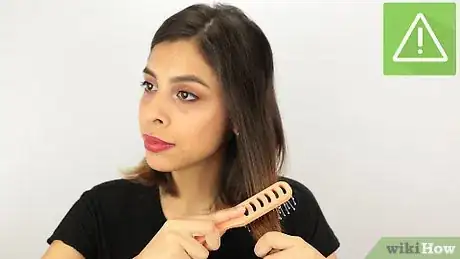
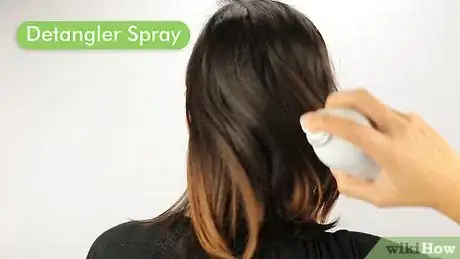
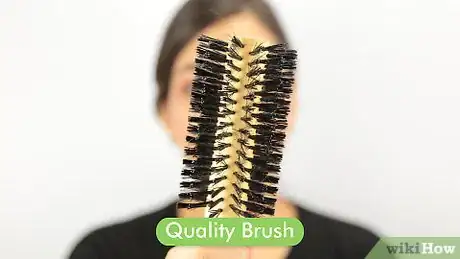

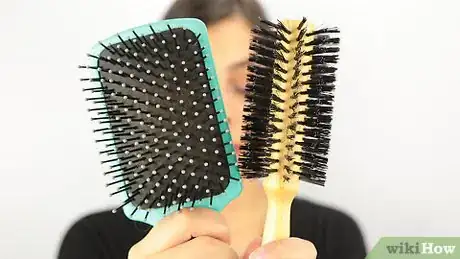
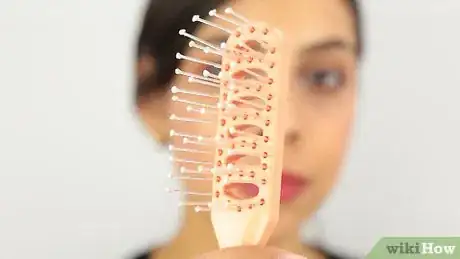

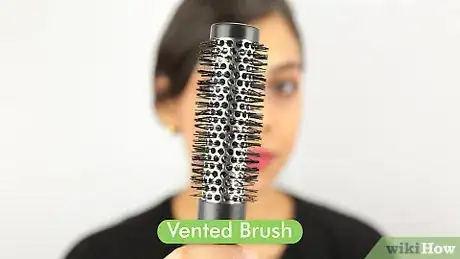
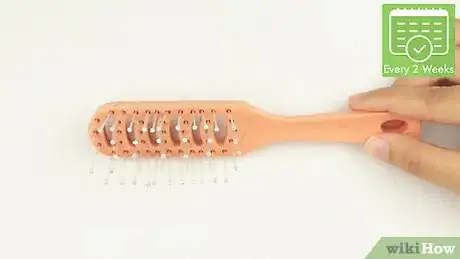
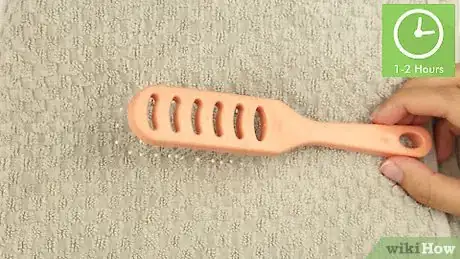
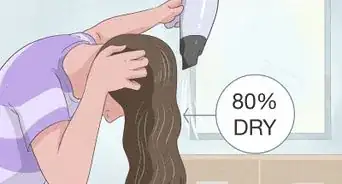
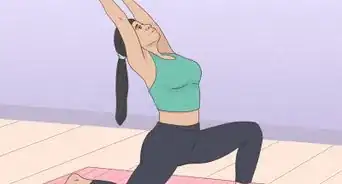
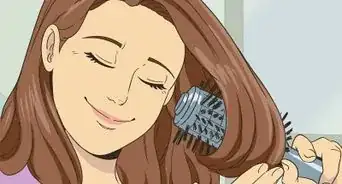
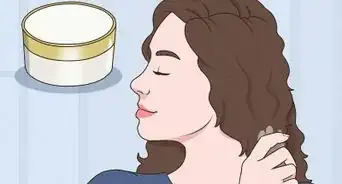
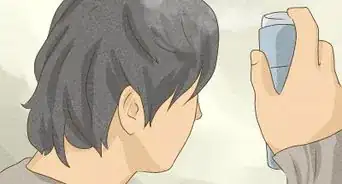
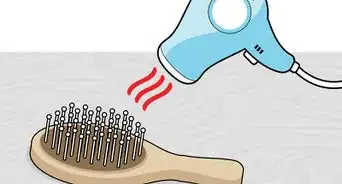
-Step-12.webp)


